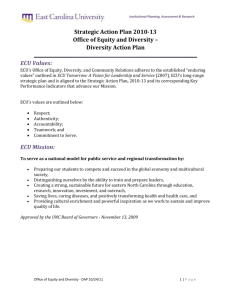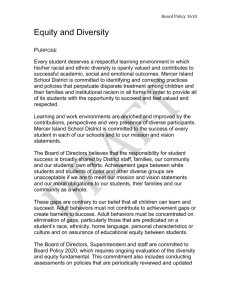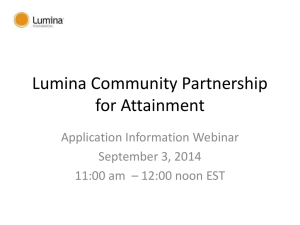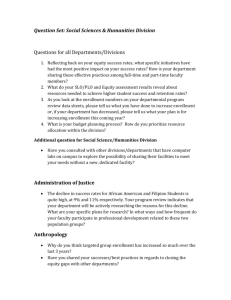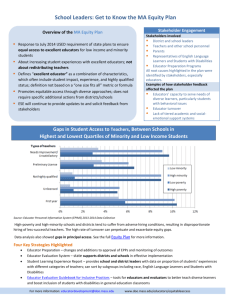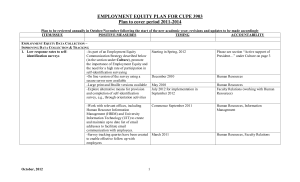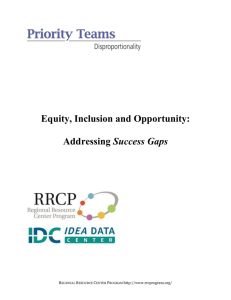suggested goals, strategies, and success factors
advertisement
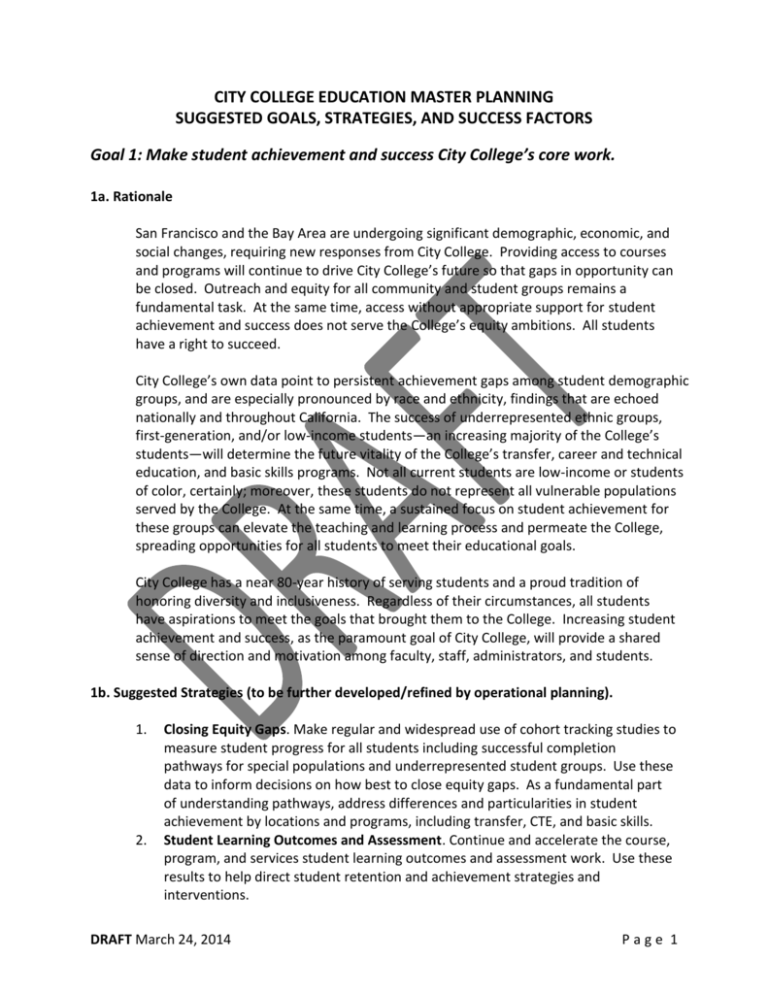
CITY COLLEGE EDUCATION MASTER PLANNING SUGGESTED GOALS, STRATEGIES, AND SUCCESS FACTORS Goal 1: Make student achievement and success City College’s core work. 1a. Rationale San Francisco and the Bay Area are undergoing significant demographic, economic, and social changes, requiring new responses from City College. Providing access to courses and programs will continue to drive City College’s future so that gaps in opportunity can be closed. Outreach and equity for all community and student groups remains a fundamental task. At the same time, access without appropriate support for student achievement and success does not serve the College’s equity ambitions. All students have a right to succeed. City College’s own data point to persistent achievement gaps among student demographic groups, and are especially pronounced by race and ethnicity, findings that are echoed nationally and throughout California. The success of underrepresented ethnic groups, first-generation, and/or low-income students—an increasing majority of the College’s students—will determine the future vitality of the College’s transfer, career and technical education, and basic skills programs. Not all current students are low-income or students of color, certainly; moreover, these students do not represent all vulnerable populations served by the College. At the same time, a sustained focus on student achievement for these groups can elevate the teaching and learning process and permeate the College, spreading opportunities for all students to meet their educational goals. City College has a near 80-year history of serving students and a proud tradition of honoring diversity and inclusiveness. Regardless of their circumstances, all students have aspirations to meet the goals that brought them to the College. Increasing student achievement and success, as the paramount goal of City College, will provide a shared sense of direction and motivation among faculty, staff, administrators, and students. 1b. Suggested Strategies (to be further developed/refined by operational planning). 1. 2. Closing Equity Gaps. Make regular and widespread use of cohort tracking studies to measure student progress for all students including successful completion pathways for special populations and underrepresented student groups. Use these data to inform decisions on how best to close equity gaps. As a fundamental part of understanding pathways, address differences and particularities in student achievement by locations and programs, including transfer, CTE, and basic skills. Student Learning Outcomes and Assessment. Continue and accelerate the course, program, and services student learning outcomes and assessment work. Use these results to help direct student retention and achievement strategies and interventions. DRAFT March 24, 2014 Page 1 3. 4. 5. Enrollment Management. Engage fully in a range of enrollment management techniques including targeted recruitment and matriculation activities, alignment of education program and services with learner needs, targeted interventions for underperforming and underrepresented student groups, continuous analysis of enrollment, student access, and achievement, and alumni follow-up. Communication and Collaborative Discourse about Student Success. Systematically engage faculty, staff, administrators, students, and community members in ongoing, transparent and clear communication and collaborative dialog about needed improvements in access and success. Use this information to make adjustments in programs, services, including learning community type interventions, course scheduling, and technology needs. Modes of Instructional Delivery. Determine the extent to which traditional educational architecture and modes of delivery (e.g., 3 credit course, 16 week semester, non-competency based structures, grading and delivery, the 55-minute class) are effective practices for learners in an information society. 1c. Examples of Success Factors (visible measures of strategy and goal attainment to be further developed in operational planning with specific activities, responsible parties, and target dates). 1. Establish rigorous metrics for tracking student achievement, including baseline student achievement data (e.g., retention rates, transfer rates, and progression through basic skills and gatekeeper classes, employment outcomes, language acquisition for noncredit ESL students). 2. Establish internal benchmarks for student progression across identified student groups and a schedule by which these benchmarks are assessed and communicated. 3. Conduct college-wide, data-informed discussions about what works in student success and achievement for City College students including the appropriateness of benchmarks. Goal 2: Improve the College’s infrastructure including procedures, technology, and facilities. 2a. Rationale City College’s physical facilities and technological infrastructure require immediate and sustained attention, especially as their present condition affects teaching and learning. This is a longstanding problem that requires deliberate planning matched with available resources. There is unlikely to be sufficient new state and local funds to correct these deficiencies, so the College will need to allocate accordingly from its current funds. This will require systematic and disciplined planning and decision-making for all of the College’s locations. DRAFT March 24, 2014 Page 2 While higher education institutions typically lag other sectors of the economy in adoption of new technologies, students entering City College are influenced by the personal technology available to them and consequently have expectations that City College cannot now match. Today’s students live in an information society, are markedly different than their predecessors, and likely will be even more different in the future. This may be especially true in the Bay Area and influences expectations about the skills students should have. In addition to addressing physical aspects of infrastructure, the College needs clear procedures across all major functions so that it can operate effectively using transparent processes and criteria. 2b. Suggested Strategies (to be further developed/refined by operational planning). 1. 2. 3. 4. Facilities Master Planning. Develop a realistic and actionable facilities master plan to match the directions established by this Education Master Plan. Technology Planning. Implement and update the CCSF 2013‐2015 Technology Plan to support upgraded classroom and other education technology. Scheduled Maintenance. Continue to focus internal scheduled maintenance funding and Prop 39 funding towards addressing critical facilities needs. Reallocate bond funds to address the myriad of facilities projects to improve the educational and learning environment. Procedures. Create clear procedures across all major functions of the College and continuously improve these procedures. For example, specific instructional procedures should address class scheduling, program development and discontinuance, class cancellation, faculty allocation, and other decision-making in the instructional area. Recently published budget development procedures need to be fully implemented and then assessed for continuous quality improvement. 2c. Examples of Success Factors (visible measures of strategy and goal attainment to be further developed in operational planning with specific activities, responsible parties, and target dates). 1. 2. 3. 4. Creation of a realistic and actionable facilities master plan to accompany this Education Master Plan. An updated CCSF 2013‐2015 Technology Plan to support student success and planning business. Existence of a list of prioritized infrastructure and modernization projects for a five- year period. Regular yearly accomplishments are shared with the College community. Publication of a comprehensive array of procedures for all major College functions. DRAFT March 24, 2014 Page 3 Goal 3: Provide new and expanded opportunities for professional and organizational development for all stakeholders to support excellent academics, student support services, and overall continuous quality improvement. 3a. Rationale A culture of collaboration, innovation, commitment, evidence, and action is required to achieve the goals set out in this Education Master Plan. For example, the demands placed on staff and faculty to increase student success will shape future work in challenging ways. At the same time that City College students are changing, advances in teaching and learning have increased rapidly. By launching this educational planning process, City College has embarked on a journey of continuous improvement that will require that all employees increase their skills and capacity to contribute to the College’s future. There is increasing awareness at City College that many issues need to be addressed that require expertise not readily available among existing staff and faculty. The College must keep abreast of critical advances that are occurring in teaching and learning as well as those advances driving effective institutional performance. Sustained improvements in performance almost never take place without professional development that moves beyond passive learning activities toward engagement strategies that include peer learning, study teams, and appropriate support. In addition to faculty, staff, and administrators, students also should be engaged in purposeful learning experiences to develop leadership skills and other traits needed for success while at City College and beyond. 3b. Suggested Strategies (to be further developed/refined by operational planning). 1. 2. Professional Development. Create sound and sustainable professional development opportunities for all administrators, staff, and faculty to meet City College’s challenges. Student Leadership. Create opportunities for students as well as the entire College community to actively engage in learning experiences that promote leadership, ethical decision-making, and communication. 3c. Examples of Success Factors (visible measures of strategy and goal attainment to be further developed in operational planning with specific activities, responsible parties, and target dates). 1. 2. A ten percent increase in the number of professional development and training activities provided for all employees in 2014-2015 over 2013-2014. A ten percent increase in student leadership development programs in 2014-15 over 2013-14. DRAFT March 24, 2014 Page 4

